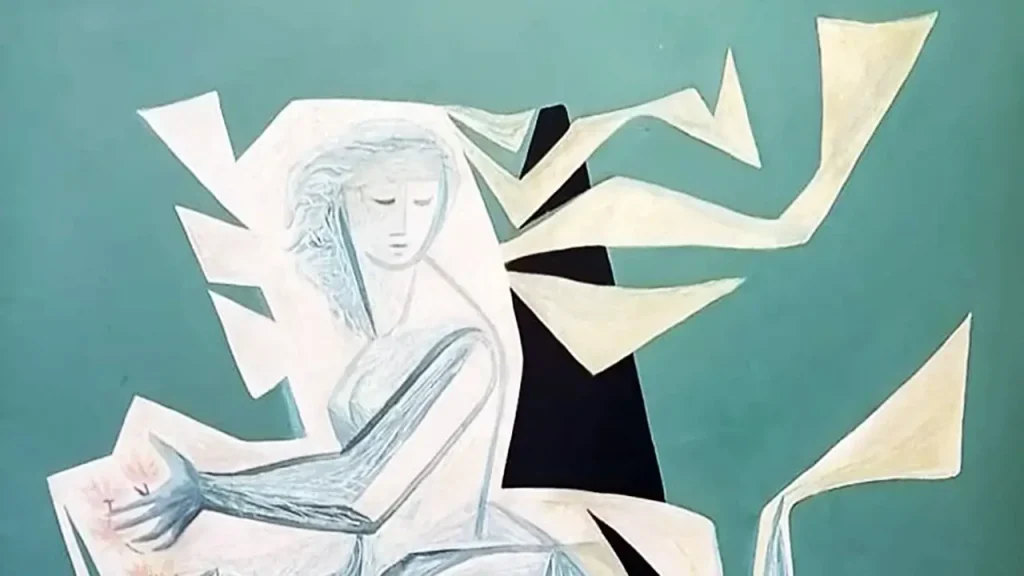4 Artworks by Maria Keil in Lisbon brings you a selection of public spots where you can appreciate some of the diverse creations that this visual artist, graphic designer, and decorator left as a legacy in our city.
In Maria Keil, Pioneer Artist of the Lisbon Metro, we explored aspects of her life and work, as well as her contribution to modern tile art, particularly her extensive involvement in the city’s underground transport network.
In this article, we’ll highlight four of Maria Keil’s significant works around Lisbon: two tile compositions, an original set of stone mosaic murals, and a wall painting. But first, a brief note on her role as a unique influence on the childhood imagery of generations.
A Generational Childhood Imagery
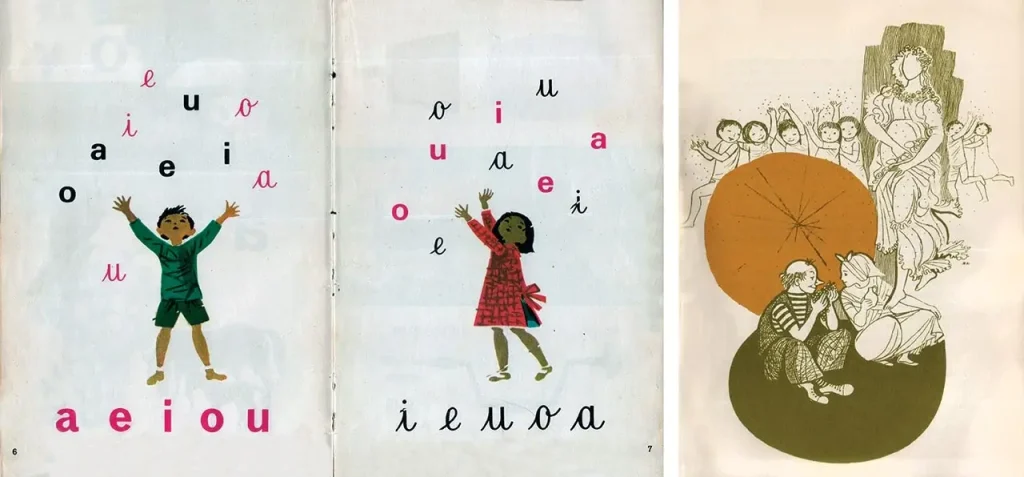
Maria Keil fascinates us not only for the undeniable quality and originality of her work and the lasting mark she left on Lisbon, but also because she was instrumental in shaping the imagery of thousands of children.
In the second phase of her career she increasingly focused on tile work and also on illustrating children’s books by authors such as Sophia de Mello Breyner Andresen, Matilde Rosa Araújo, and Maria Cecília Correia.
The artist rejected the idea of undervaluing children, viewing them as an audience deserving of the highest respect. For this reason, her illustrations reflect her humanist spirit, social concerns, and references to erudite models.
We must highlight her partnership with Luís Filipe Abreu in illustrating reading books for the 1st and 2nd grade of primary school and the 1st and 2nd grade of preparatory school, which were used by all students in these grades between 1967 and 1974.
The stylised, linear, and vividly coloured drawings of Maria Keil, with their apparent simplicity, have shaped the visual education of generations, and this is far from a minor legacy.
Maria Keil’s Artworks in Lisbon
We have selected four pieces by Maria Keil that can be observed in public spaces. We begin with two distinct tile panels: a public commission from the Lisbon City Council and the other, a smaller private commission now relocated to a public setting. Following these, we present two decorative works created for commercial spaces.
These four interventions provide a strong illustration of the diversity of Maria Keil’s legacy in Lisbon.
O Mar, in Infante Santo Avenue
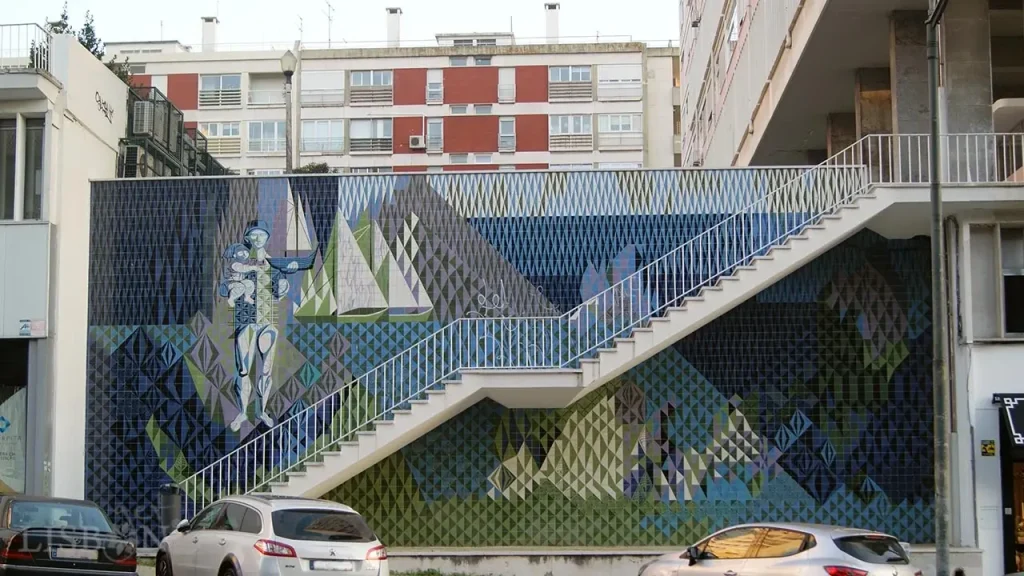
As noted, Maria Keil’s major tile work took place during the 1950s with her contributions to the Lisbon Metro. O Mar (the Sea), in Infante Santo Avenue (1958), was created in the same period and may be her most remarkable work, as it was free from external constraints. The only limitation was imposed by the architectural surroundings, which, we dare say, inspired her to produce the most impressive of the four pieces present there. The design aligns seamlessly with the space, integrating even the staircase as a cohesive element.
This panel was one of a series commissioned by Lisbon City Council, involving five visual artists, to cover large blind walls intersected by staircases created during the construction of a housing complex designed by architects Alberto José Pessoa, Hernâni Gandra, and João Abel Manta.
Maria Keil, Carlos Botelho, Alice Jorge in collaboration with Júlio Pomar, and Rolando Sá Nogueira were the chosen artists for this challenging project. In this case, Keil’s experience as a graphic designer and decorator gave her an edge over some of the more prominent visual artists.
As was her habit, she started with a simple geometric module — in this case, a diamond shape. Through repetition, variations in size, and colour shifts, she created rhythms and a sense of three-dimensionality, blending these with figurative elements into a perfectly balanced and coherent whole. The colours range from blues and greens to pink, violet, black, and white, evoking a marine atmosphere.
The design features a fisherman holding a child with his right arm and a boat in his left hand. The figures are surrounded by a mandorla, reminiscent of saintly iconography. In the background, boats with billowing sails and scattered shells and conches blend into the geometric base pattern.
In our interpretation, this fisherman may represent Saint Anthony, Lisbon’s beloved patron saint, holding the child. Here, however, rather than a book, he holds a boat, symbolising the legacy he will pass on to his son: the knowledge of his daily work, a symbol of social immobility and the fate handed down from parents to children. This boat may also symbolise the city itself and, with the composition as a whole, Lisbon’s relationship with the Tagus River.
A Festa, at the Orlando Ribeiro Library
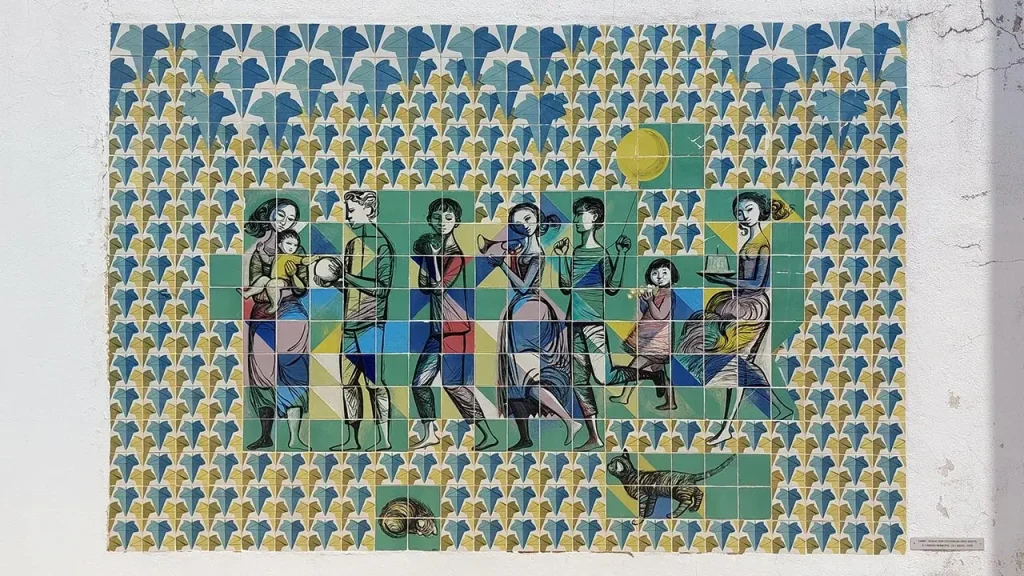
The tile panel A Festa (The Feast) was also produced in the 1950s, this time commissioned by a private client. In 2016, it was donated to the Lisbon City Council (CML) by its owner, Tito Magalhães Basto, and can now be admired at the Orlando Ribeiro Municipal Library.
As in the panel O Mar, we observe a geometric background that repeats and transforms. However, this time, the module is figurative, featuring a clearly identifiable leaf whose varying sizes transport us to the physical space of a garden. In this case, the figures blend less with the background compared with the previous work, as the artist opted for solid colours.
The scene to the left shows a couple holding a child, alongside several other figures: men, women and a child, all holding festive objects. This group in a garden setting suggests a birthday celebration, but perhaps it’s more than that.
This composition evokes a nativity scene, a theme Maria Keil often explored in her illustrations. In other words, we might be looking at a Holy Family, where the father offers a ball to the child—possibly representing the world, a motif frequently associated with the image of the Christ Child. The other figures are not simply at the celebration; they’re in movement, approaching the couple, playing instruments, bearing gifts, flowers, joy—symbolised by a yellow balloon—celebration and light, embodied by the cake with a candle carried by the last woman.
We also see cats scattered throughout the scene, echoing the role of shepherds’ sheep in the sacred narrative. The background leaves reinforce this interpretation, as they resemble vine leaves — a deeply Eucharistic symbol.
We observe an evident parallel here, but are we witnessing the secularisation of a nativity scene, or rather the sanctification of an everyday event, the celebration of a child’s birthday? Perhaps every child should be celebrated and thereby sacralised…


Maria Keil Room at the Cervejaria Trindade

At the historic Cervejaria Trindade, after passing through magnificent spaces adorned with exuberant and exotic polychromatic tiles, we come to a room featuring wall mosaics by Maria Keil. These mosaics are made in the style of Portuguese pavement, with black, white, grey, and pink stones.
In 1946, just after World War II, Maria Keil was commissioned to decorate this area, which had been closed for ten years. Since 1864, it had served as a brewery in what was once the church, cloister, and refectory of the Convent of the Holy Trinity — a 13th-century building partially destroyed by a fire, then later ruined by the 1755 earthquake , and finally dissolved with the religious orders’ extinction in 1834.
This room has a unique history: from 1959 to 1972, it operated independently from the brewery as a restaurant called “O Folclore,” aimed at tourists and promoting folk art as a showcase for the dictator regime. When the restaurant closed, the space was reintegrated into the iconic Cervejaria Trindade, where today, the mosaics can still be admired.
Executed in the traditional cobblestone technique, the eight designs depicting vases of flowers, fruit bowls, and birds exemplify the simplification of forms through geometrisation, perfectly illustrating mid-20th-century modernism, as well as the versatility and diversity of Maria Keil’s work.
| Never miss another article | Subscribe here |
A Recently Discovered Mural
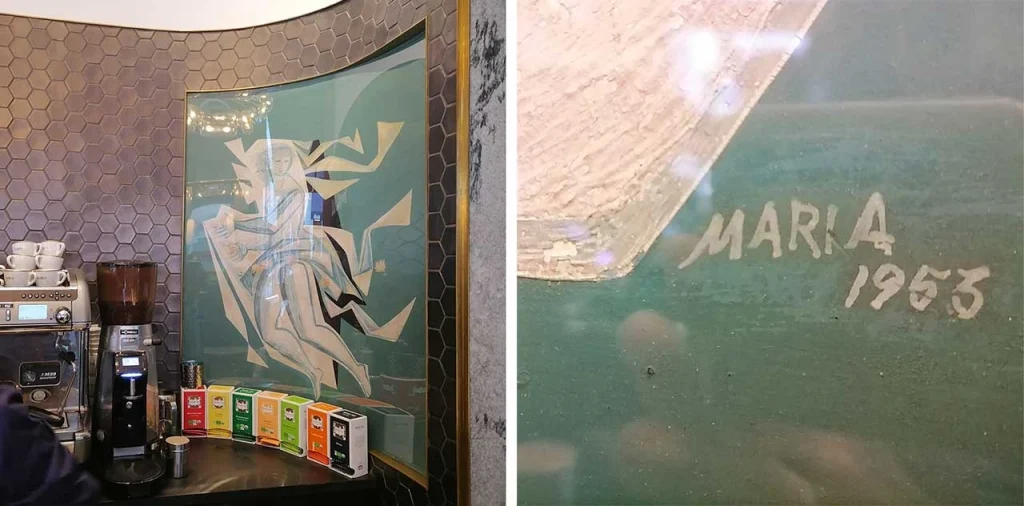
We end this short route through Maria Keil’s artworks in Lisbon with the most unexpected of her creations — a small, forgotten mural that has recently resurfaced for all to admire.
At No. 254 in Rua do Ouro, on the northern corner with Rua de Santa Justa, there once stood a particularly unique perfumery, Vogue. Opened in 1952, this shop became a landmark among Lisbon’s perfumeries, being the first to sell Dior, Chanel, Yves St. Laurent products, Austrian and French fashion jewellery, among others.
The shop was small, despite at one time having employed eight staff members, but it contrasted with the impressive size of its display windows lining both streets. On display, besides perfumes and cosmetics, were antique powder boxes, extravagant fashion jewellery, and mannequin heads adorned with turbans—now somewhat out of fashion, but all the more fascinating for it.
As is often inevitable, and perhaps exacerbated by the pandemic and real estate pressures, this Pombaline Downtown icon closed its doors.
In 2022, during renovations of the space by the Atelier de Pastéis de Nata Castro, wall mirrors were removed, revealing an unexpected mural —a signed and dated artwork by Maria Keil from 1953.
This painting, created to embellish a luxurious space dedicated to feminine beauty, depicts a young woman draped in stylised fabrics, with flowers in her hands and surrounding her. The composition flows despite its evident modernist geometric stylization.Observing this image brings to mind Primavera by Italian Renaissance painter Sandro Botticelli, with the figure echoing the nymph attempting to escape the advances of Zephyr, the wind god. The black marks contrasting with the green background and the white of the young woman’s skin and veils might even represent this ominous, shadowy figure.
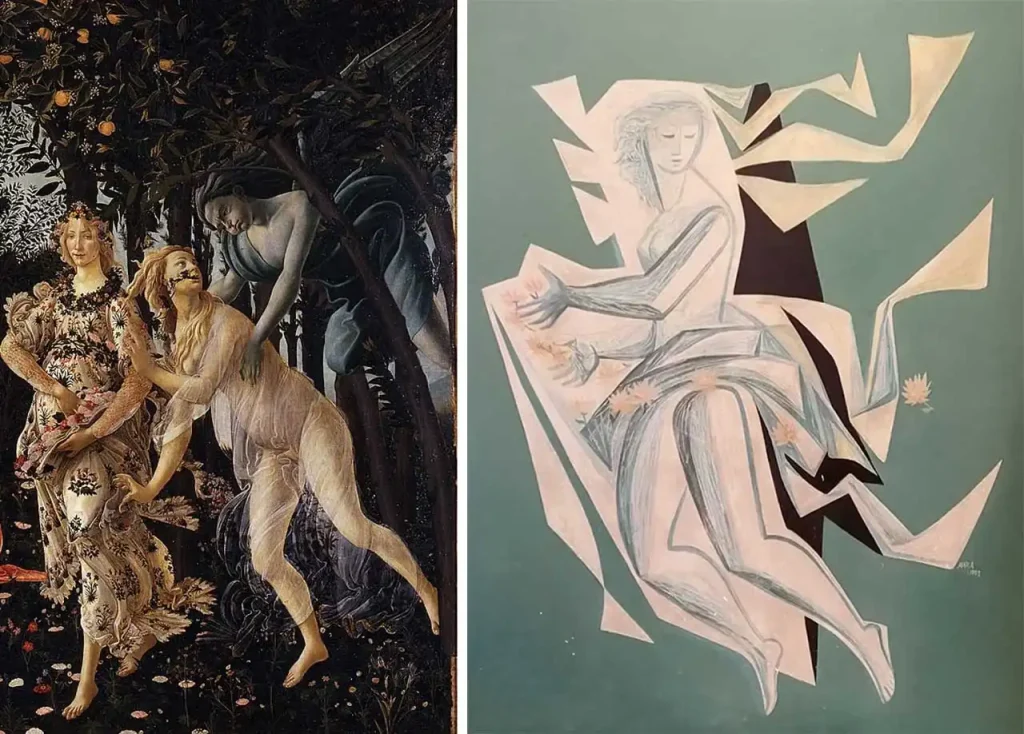
This is a happy story, as the new tenant showed sensitivity by identifying, restoring, and preserving this artistic heritage, shaping the space’s décor around this rediscovered gem.
We close this article on some of Maria Keil’s works in Lisbon with an invitation: visit Castro to enjoy a delicious pastel de nata while you admire this painting.
The project getLISBON has been very rewarding and we want to continue revealing the singularities of fascinating Lisbon.
Help us keep this project alive!
By using these links to make your reservations you’ll be supporting us. With no extra costs!
• Looking for a different experience? We can create a customised itinerary based on your interests. Contact us!
• Or if you prefer tours and other activities in various destinations, take a look at GetYourGuide.
• Save time and money with a flexible Lisbon Card!

